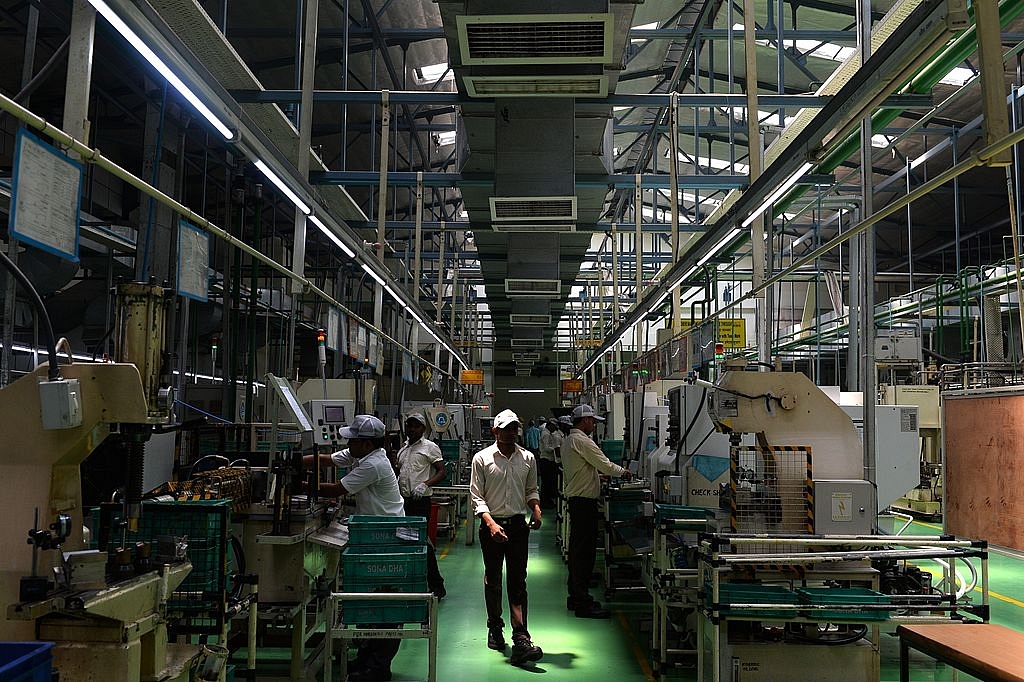Economy
How Small Is Large In India? (Or) Why Big Is Not Bad?
- The policy response to ‘big’ cannot be that ‘big is bad’ and that the only policy response to them is tax raids, notices, searches and seizures and revolutionary rhetoric.
- This is where policy attention has to be on, in the next two years, if not longer.

Workers manage machines at a factory of Sona Koyo Steering Systems in Dharuhera, south of New Delhi. (Chandan Khanna/AFP/Getty Images)
In late June, the Ministry of Statistics and Programme Implementation in India (MoSPI) had uploaded this document. It went, as far as I know, unnoticed. But, I cannot be sure. I had begun to travel heavily then. It might have been covered in the media.
It is a press note on the key findings of a survey of unincorporated non-agricultural enterprises excluding construction, conducted during the period 2015-16.
I had tried to distil some very key findings and compare them to the factories registered with the Annual Survey of Industries (ASI) . The latest ASI that is available is for 2014-15.
Most of the unincorporated non-agricultural enterprises are ‘Own Account’ enterprises. Yes, some of them render a useful social function. No doubt. They contribute social capital. But, they tie up valuable resources like land, power, water, etc., and unlikely that they pay for them. Those who employ outside workers do not pay them well as you can see above. They cannot. These are subsistence enterprises.
No, the answer is not that India does a ‘Turkman gate’ on them. Political and social dynamite, such an approach would be.
But, policy options are clear:
If they become formal (only 31 per cent of these enterprises are registered) and if they have to be given access to finance (not all of them should be given), then there should be some criteria on their improvement – workers, emoluments, protection of workers and also productivity. That is what MUDRA loans should aim at. But, only a small fraction of them will go on to make it somewhat big, if not BIG.
This is where demonetisation comes into play. It might have made life difficult for many of these enterprises that operate on cash. So, the social capital they generate is disrupted. That is a negative. Some of them will become poorer as a result. That is an economic consequence. That is worse.
But, how many of them will also be enabled to grow out of their humble origins to which they are condemned for life, now? How many of them can make it? For those who cannot continue now with their humble enterprises, do we know how to train them and absorb them in bigger and formal enterprises? How many of them do we have, actually? What are we doing to them? That is what we turn to, next. We examine the Annual Survey of Industries (ASI), 2014-15. That is the latest available ASI.
ASI registered firms add more gross value (GVA), pay better and the bigger ones among them (500 or more workers) are even better on these two parameters.
But, the killer punch comes in the last five lines of the table above. The proportion of factories that employ more than 500 workers is barely above 4 per cent. But, their GVA per worker is 150 times more than the factories that employ 499 or less workers. Their GVA per worker is 14 times more than the overall GVA per worker (which includes factories with more than 500 workers)!
While the government of India can pursue all the taxes that these big enterprise (factory) owners have to pay, it should also spare a thought as to the economic value added of these bigger units.
Per policy minute or policy hour spent, their economic value added is far more than unincorporated enterprises. There is much to do and should be done to ease their business conditions even as they are held accountable to obey the laws of the land in all aspects and pay their workers better.
But, India needs to have more of them. How much more is optimal is surely worth debating because, at some tipping point, scale can be wasteful. But, surely not 4.1 per cent. That is why policy response to ‘big’ cannot be that ‘big is bad’ and that the only policy response to them is tax raids, notices, searches and seizures and revolutionary rhetoric.
This is where policy attention has to be on, in the next two years, if not longer.
(PS: I might have made calculation errors. But, all the source data are available in the press release on unincorporated enterprises linked above and in the ASI report (page 59) linked above. You can point out errors, if any. Will be grateful).
This piece was first published on The Gold Standard and has been republished here with permission.
Introducing ElectionsHQ + 50 Ground Reports Project
The 2024 elections might seem easy to guess, but there are some important questions that shouldn't be missed.
Do freebies still sway voters? Do people prioritise infrastructure when voting? How will Punjab vote?
The answers to these questions provide great insights into where we, as a country, are headed in the years to come.
Swarajya is starting a project with an aim to do 50 solid ground stories and a smart commentary service on WhatsApp, a one-of-a-kind. We'd love your support during this election season.
Click below to contribute.
Latest